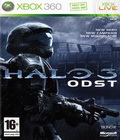For a game that started life as an expansion pack and was produced in a mere 14 months, Halo 3: ODST is an impressive piece of work. It packs a level of content on par with titles that have been in development twice as long and never gives the player a feeling of being rushed. When Bungie says that the game grew into a full-length experience, it's not just marketing speak. This is a title that's well worth your gaming dollar.
Creating a completely new game within an established franchise is always a challenging task. Change the wrong thing or tweak an established feature, and you run the risk of angering your core fans. Hell, Bungie saw a backlash when it introduced the Arbiter as a playable character in Halo 2. Compared to the changes in Halo 3: ODST, that was a relatively minor addition. Not all change is bad, though, and in some ways, Halo 3: ODST is actually a better game than its predecessors.
Set in between the events of Halo 2 and Halo 3, Halo 3: ODST runs off the Halo 3 engine, but it revamps the style of play into something familiar yet still different enough to feel fresh. Master Chief is gone, as is his fully rechargeable health bar and ability to dual-wield weapons. The story line is tight and well-scripted, even though you have the ability to play through most of the levels in any order. AI seems to have improved, especially on the part of your teammates, so they no longer feel like mere cannon fodder.
As a member of the elite ODST, you and your squad have been tasked with a mission into New Mombasa, which is under attack by the Covenant forces. Because the mission is top secret, you don't know what the ultimate goal is when you launch. In fact, much of the story is spent learning exactly what it is that you are supposed to do.
Featuring a more cinematic atmosphere than previous Halo games, Halo 3: ODST's campaign story line takes time to focus on each of the individual members of your squad. Rather than just toss you into the firefight, time is taken to explore the different characters by way of flashback missions. Because one of the Covenant ships jumped out while you were dropping to the surface, your pod was damaged and you were knocked out. Thus, the events of the last six hours are a mystery. As you explore the hub level of New Mombasa, you will discover key artifacts, each of which triggers a flashback to the events that occurred while you were out. Altogether, the flashbacks tell a detailed story, but they are structured such that even if played out of order, everything still makes perfect sense. Once you've finished the six flashback missions, the final two missions occur in "real time."
Helping to enhance the game's presentation are the top-notch performances of the three main voice actors, Nathan Fillion, Adam Baldwin and Alan Tudyk. The trio plays three of your four squadmates, instilling each with a memorable personality — though Fillion is easily the star of the bunch. Taking on the role of Gunnery Sergeant Buck, Fillion fills the role of veteran squad leader. Whether you're playing as Buck or alongside him, Fillion often makes the character seem larger than life thanks to his portrayal. Fans of the television show "Firefly" will also note an uncanny similarity to the way Fillion played Captain Mal Reynolds on the show. While it isn't the same character, Buck could easily be Mal's twin brother, both in attitude and action.
Contributing to the game's atmosphere is the completely new musical direction. Rather than sticking with the bombastic score common to prior titles, Halo 3: ODST's background music takes a more subtle approach and features a variety of music. While you're exploring the nighttime hub world of New Mombasa, the music is subdued and restrained. Jump into a flashback, and the audio kicks it up a notch.
Combat takes a different turn thanks to the OSDT style damage meter. Instead of a single rechargeable meter like Master Chief, you now have a health bar as well as a stamina bar, which is effectively a shield. Your stamina will recharge automatically, but your health will not. In order to refill your health, you must find a medpack. The mechanic may be a genre throwback, but it adds an additional level of depth to the fighting. Unlike Halo 3, you can't just fight until you're at a hair's breadth of health, rest and then do it again. Yes, your stamina gives you a buffer here, but that's little assurance when your core health is precariously low.
Compared to Master Chief, the ODSTs may have an armor disadvantage, but they do have one thing he doesn't: the VISR. Short for Visual Intelligence System Reconnaissance Class, the VISR is an optional light-enhancing target recognition system. Incredibly useful in low-light situations, the VISR highlights both friend and foe, making it extremely easy to pick out hostile forces. With the VISR enabled, you'll never have to wonder where that last shot came from. The VISR's only weakness is bright light. Because it increases the overall brightness level, using the VISR in well-lit areas can be difficult.
Companion AI is another strong point of the game. Anyone who's played through the first level of Halo 3 can attest to the Arbiter's ability to function as a punching bag, but he wasn't always the most effective fighter. Not so here. No matter who you are partnered with, your teammates all appear to be effective fighters. They can hold their own in combat and, so long as you are also playing an active role, will take down their fair share of Covenant forces.
Visually, Halo 3: ODST looks a bit better than its predecessor, but not by a whole lot. The Halo 3 engine is still powering things under the hood, and that means the game is also saddled with its limitations, including some visibly jagged edges from time to time. It's by no means a show stopper and doesn't impact gameplay, but when you compare Halo 3: ODST to the visuals of a current title, such as Call of Duty: Modern Warfare 2, it does start to show its age.
Where Halo 3: ODST stumbles is in the vehicle controls. Why Bungie ever decided that mapping steering and looking to the same analog stick was a good thing will be a mystery most likely lost to the sands of time. The end result is a feeling of extreme chunkiness when on the ground with a Warthog or driving a Scorpion tank. If you're used to the "Halo way" of driving, you won't think anything of it, but a newbie to the series is bound to find the default driving controls somewhat frustrating. This is compounded by the fact that one of the levels in the game requires you to drive a Warthog for half of the level. Thankfully, that is the only real low point in the campaign.
All in all, it took us approximately 9.5 hours to complete the single-player campaign on Heroic difficulty. Content-wise, Halo 3: ODST has about as much in the single-player campaign as its predecessors. It's good to know that Bungie didn't skimp out. Of course, the campaign isn't the only aspect of the game.
Aside from the single-player game (which can also be played through in co-op), Halo 3: ODST also features a co-op multiplayer mode called Firefight. Similar to the Horde Mode in Gears of War 2, Firefight pits four human players against wave after wave of Covenant forces. The waves are randomly generated, though things do get progressively more difficult as you progress due to the skull modifiers. Firefight is a true test of skill, as it doesn't have an ending. Your team simply fights until it is dead. The catch is that you have a shared pool of lives, so one weak link can bring down an entire team. While reviewing the game, we saw some Firefight matches exceed an hour in play time. There's no doubt that this is going to be a popular gameplay mode on Xbox Live.
Adding a bit more to the package is the inclusion of the entire Halo 3 multiplayer experience. Included on a second disc, this contains the Halo 3 multiplayer engine plus all of the officially released map packs, plus an additional three maps that are currently exclusive to the Halo 3: ODST package. In short, it is everything Halo 3, except the single-player campaign. For veteran players, having everything on a single disc is a matter of convenience. It also gives you the ability to free up some hard drive space, as you no longer need any of the downloaded map packs. They're all on the disc.
For new players, or those who never purchased any of the Halo 3 map packs (Heroic, Legendary and Mythic), the multiplayer disc is a great value. Since its release, the Heroic map pack has become a free download, but purchasing the Legendary and Mythic map packs today would set you back 1400 Microsoft points, or about $17.50. Add in the three extra maps, which would likely sell for $10 if they were available separately, and you're looking at nearly $30 worth of included DLC content.
Finally, there's the promise of access to the Halo: Reach beta. Purchase Halo 3: ODST, and you get a guaranteed beta invite on the game disc. It's very similar to how owners of Crackdown were all given access to the Halo 3 beta.
Halo 3: ODST may have started as a side project at Bungie, but the finished product has become something that is much more than the sum of its parts. Thanks to a combination of well-designed levels, a solid story line, addicting multiplayer and top-notch voice acting, Halo 3: ODST presents a package that is even more compelling than its namesake. The game is not only better than Halo 3; it is the best Halo title to date. And, planned or not, Bungie has also managed to create a compelling character in Gunnery Sergeant Buck. He is just as much the hero as Master Chief ever was. Here's hoping that we see more of the smartass sergeant in Halo: Reach.
Score: 9.5/10More articles about Halo 3: ODST










 Halo 3: ODST (Orbital Drop Shock Troopers) is a new chapter in the Halo saga that lets gamers experience events leading up to the epic story told in Halo 3 through the eyes of a new hero in the Halo universe. The stand-alone expansion extends the Halo 3 experience with hours of new campaign excursions and multiplayer gameplay.
Halo 3: ODST (Orbital Drop Shock Troopers) is a new chapter in the Halo saga that lets gamers experience events leading up to the epic story told in Halo 3 through the eyes of a new hero in the Halo universe. The stand-alone expansion extends the Halo 3 experience with hours of new campaign excursions and multiplayer gameplay.
























































